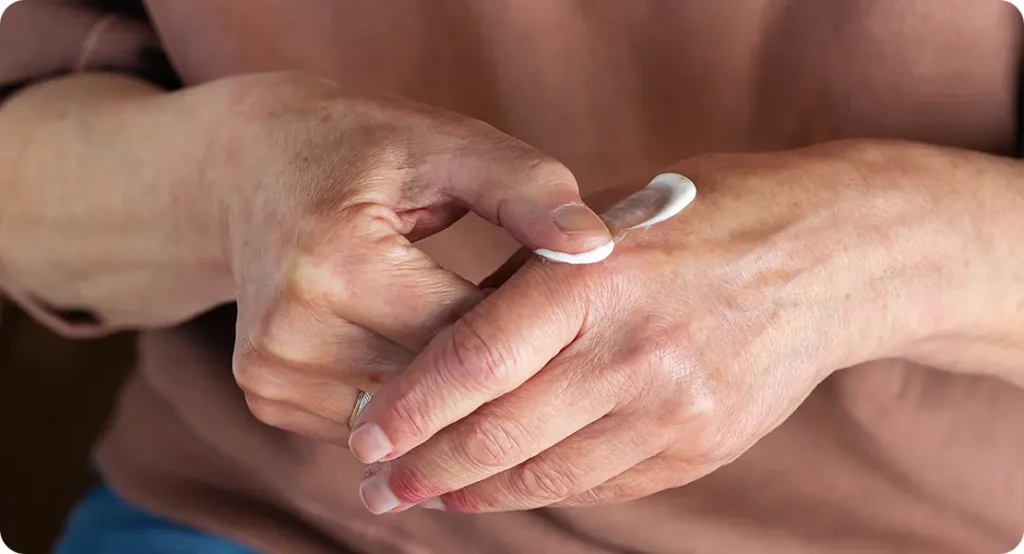If you or someone you love lives with eczema, then you know just how relentless and frustrating it can be. The constant itching. The cracked, inflamed skin that flares up without warning. The emotional toll it takes, especially when the usual creams or ointments don’t seem to work. It can feel like a never-ending cycle of discomfort and disappointment.
But here’s the good news: we’re living in one of the most exciting and hopeful times in eczema care. Over the last several years, researchers and dermatologists around the world have been diving deeper into the biology of eczema. They’re not just looking at the surface symptoms anymore they’re uncovering what’s happening inside the body at a cellular and genetic level. And that shift in understanding is changing everything.
New treatments are emerging that don’t just mask the symptoms they target the actual mechanisms driving inflammation and flare-ups. From breakthrough biologic drugs that block specific immune pathways to high-tech tools that help track triggers and personalise care, these advances are already improving outcomes for people with moderate to severe eczema. Even better, many of these innovations are designed with long-term safety in mind, making them more sustainable for chronic use.
In this article, I’ll walk you through some of the latest discoveries and most promising treatments in eczema research. Whether you’ve had eczema for years or you’re just starting to seek answers, this update will give you a clearer picture of where eczema care is headed and what it might mean for your skin, your health, and your quality of life.
Let’s dive into the future of eczema treatment.
Why Eczema Is So Challenging to Treat
Before we dive into the latest breakthroughs, it’s important to understand why eczema can be so difficult to manage in the first place. While many people assume it’s just a case of dry or sensitive skin, eczema also known as atopic dermatitis is far more complex than that.
At its core, eczema is a chronic inflammatory condition of the skin. It’s not caused by a single issue, but rather a combination of internal and external factors that interact in ways we’re only beginning to fully understand. This complexity is one of the reasons why treating eczema can be so challenging and why a one-size-fits-all approach often falls short.
Here’s what makes eczema such a stubborn and persistent condition:
- An overactive immune system: In people with eczema, the immune system tends to overreact to harmless substances, causing inflammation that leads to redness, swelling, and that all-too-familiar itch.
- A weakened skin barrier: Healthy skin acts as a strong, protective barrier that locks in moisture and keeps irritants out. But in people with eczema, this barrier is often compromised. That means moisture escapes more easily, and irritants, allergens, and bacteria can get in more easily fueling the cycle of irritation and flare-ups.
- Environmental and emotional triggers: Everyday factors like heat, cold, humidity, stress, dust, pollen, soaps, and even certain fabrics can trigger eczema flare-ups. And since everyone’s triggers are different, identifying and managing them can be a frustrating process of trial and error.
- Genetic predisposition: Eczema tends to run in families. If you have a parent or sibling with eczema, asthma, or hay fever, you may be more likely to develop it yourself. Certain gene mutations, such as those affecting the protein filaggrin (which helps build the skin barrier), are known to increase eczema risk.
Because of this multi-layered nature, treating eczema isn’t as straightforward as just applying a moisturiser or steroid cream. Those may help soothe the skin temporarily, but without addressing the underlying causes, the relief is often short-lived.
That’s why the goal of modern eczema therapy is not just to calm the surface symptoms it’s to take a multi-pronged, holistic approach that addresses the condition from several angles:
- Reduce inflammation deep within the skin using targeted medications
- Strengthen and repair the skin barrier with emollients and barrier-enhancing ingredients
- Minimise itching and prevent scratching, which can lead to further damage and infection
- Lower the risk of secondary infections by maintaining good skin hygiene and addressing bacteria
- Identify and manage personal triggers to help prevent future flare-ups
This is exactly where the most exciting innovations are happening today. Researchers are developing smarter, more targeted therapies that address these core issues more effectively and with fewer side effects. Let’s take a closer look at what’s new in eczema care and why it’s giving both patients and dermatologists new reasons to feel hopeful.
New Biologic Treatments

One of the most exciting areas of eczema research involves biologic medicines. These are targeted injections that interrupt the specific immune pathways responsible for inflammation in eczema.
Dupilumab (Dupixent)
The first biologic approved for moderate-to-severe eczema, Dupilumab has been a game changer for many patients who didn’t respond well to topical treatments.
- How it works: Dupilumab blocks two key proteins (IL-4 and IL-13) that drive inflammation.
- Results: In studies, more than half of patients saw their eczema symptoms reduced by at least 75%.
- Safety: Overall, it’s well-tolerated, with the most common side effects being mild eye irritation or injection site reactions.
Emerging Biologics
In recent years, biologic therapies have revolutionised the treatment landscape for moderate to severe eczema, especially in patients who haven’t responded well to traditional treatments. In addition to existing options like dupilumab, several new biologics are currently in development or have entered early use, offering renewed hope for those with stubborn or widespread eczema.
- Tralokinumab – This is an injectable biologic that specifically targets interleukin-13 (IL-13), a key cytokine involved in the inflammatory process of atopic dermatitis. By blocking IL-13, tralokinumab helps reduce skin inflammation, redness, and itching. It’s shown encouraging results in clinical trials and is now approved in some regions for the treatment of moderate to severe eczema.
- Lebrikizumab – Similar to tralokinumab, lebrikizumab also targets IL-13, but it binds at a different site, offering a slightly different mechanism of action. Trials have demonstrated promising improvements in skin clearance and itch reduction, with a good safety profile. Dermatologists are hopeful that lebrikizumab may become another reliable option in the eczema treatment arsenal.
- Nemolizumab – This biologic works by targeting the IL-31 receptor, which plays a central role in the sensation of itching. Severe itching is one of the most distressing symptoms for people with eczema, often leading to sleep disturbances and reduced quality of life. By interrupting the IL-31 pathway, nemolizumab could help patients gain relief from chronic itch and improve overall skin comfort.
These emerging biologics are still undergoing research and regulatory evaluation in many parts of the world. However, they represent an exciting future for eczema management potentially allowing dermatologists to personalise treatment plans based on individual immune responses and symptom severity.
Smarter Topical Treatments

While injectable biologics have become game-changers for individuals with moderate to severe eczema, the majority of patients especially those with mild to moderate symptoms still rely heavily on topical therapies as their primary line of defence. These treatments remain essential for managing flare-ups, soothing irritation, and maintaining long-term control of the condition. Fortunately, innovation in this space hasn’t been left behind.
In recent years, researchers and pharmaceutical companies have been working on developing smarter, more targeted topical treatments that go beyond traditional corticosteroids. These newer options aim to minimise side effects while improving efficacy, especially for long-term use.
One notable development is topical Janus kinase (JAK) inhibitors, such as ruxolitinib cream. These work by blocking specific inflammatory pathways inside the skin cells, reducing redness, itchiness, and swelling. Unlike steroids, JAK inhibitors don’t cause thinning of the skin, making them a safer option for delicate areas like the face, eyelids, or underarms Another advancement is non-steroidal topical creams like crisaborole, a phosphodiesterase-4 (PDE4) inhibitor. This cream targets inflammation at the cellular level and is approved for both adults and children with mild to moderate eczema. It’s often well-tolerated and offers an alternative for those who want to avoid or reduce steroid use.
Formulation science has also evolved. New delivery systems such as lipid-based vehicles and nano-emulsions help active ingredients penetrate deeper into the skin barrier while reducing irritation. These enhancements improve how well the treatment works and how pleasant it is to use, which can greatly improve adherence to therapy.
In short, topical treatments are becoming more sophisticated, personalised, and user-friendly. This progress is crucial because daily application and skin maintenance are still the cornerstone of eczema management for many patients
New Non-Steroid Creams
For decades, topical corticosteroids have been the go-to treatment for eczema flare-ups, thanks to their strong anti-inflammatory effects. However, while they can be highly effective in the short term, long-term or excessive use comes with a well-known list of potential drawbacks. These include skin thinning (atrophy), delayed wound healing, and even systemic absorption in some cases, particularly when used on large areas or delicate skin like the face or around the eyes. Understandably, many patients and parents have concerns about using steroids over long periods especially for children.
In response to this, researchers have developed newer, non-steroidal topical treatments that offer promising alternatives without the same risks. Two types in particular are making headlines and gaining traction among dermatologists and patients alike:
- Topical PDE4 Inhibitors (e.g., Crisaborole):
These creams work by inhibiting phosphodiesterase-4 (PDE4), an enzyme that plays a key role in triggering inflammation in eczema. By reducing the levels of pro-inflammatory messengers in the skin, PDE4 inhibitors help calm irritation and restore comfort. Crisaborole is the most widely available option in this category and is approved for use in patients as young as two years old. It’s particularly helpful for those with mild to moderate eczema and is safe for application on sensitive areas like the face, neck, and skin folds. Since it doesn’t contain steroids, many parents and long-term sufferers appreciate its gentler approach. - JAK Inhibitors (e.g., Ruxolitinib Cream):
This is one of the newest classes of topical treatments available for eczema. JAK (Janus kinase) inhibitors work by interrupting signalling pathways inside immune cells that contribute to inflammation and itch. Ruxolitinib cream, in particular, has shown rapid results in reducing itching and redness often within a few days of use. It’s generally well-tolerated and is especially beneficial for people whose eczema is resistant to other topical treatments. As with any medication, proper application and medical guidance are key to avoiding potential side effects, but early studies and real-world use suggest a favourable safety profile.
These new non-steroid creams represent a welcome shift in how we approach eczema care providing effective, well-tolerated options for people who either can’t use steroids or prefer not to. If you’ve been struggling to find the right topical solution or are concerned about the long-term effects of corticosteroids, it’s definitely worth discussing these innovative treatments with your dermatologist.
Barrier Repair Therapies
Eczema isn’t just about calming inflammation it’s also about rebuilding the skin barrier. Research has shown that applying barrier repair creams can significantly reduce flare-ups.
Examples include:
- Prescription emollients containing ceramides
- Formulas enriched with natural lipids
- Moisturisers designed to balance the skin microbiome
In the past few years, many new barrier repair products have hit the market, giving patients more choices tailored to their skin type.
Therapy Advances
When eczema doesn’t respond well to creams, ointments, or oral medications, light-based treatments collectively known as phototherapy can offer an effective alternative. Phototherapy involves the controlled exposure of the skin to specific wavelengths of ultraviolet (UV) light to reduce inflammation, itching, and irritation.
Over the years, researchers and dermatologists have worked to refine these light-based therapies, improving their safety and effectiveness. Newer forms of phototherapy aim to deliver maximum benefit while minimising side effects such as burning or premature skin ageing.
Narrowband UVB Therapy is now considered one of the most advanced and widely used methods. Unlike older, broad-spectrum UV treatments, narrowband UVB uses a very specific wavelength (311–313 nm) of light. This wavelength is particularly effective at calming inflammation and controlling eczema flare-ups while significantly lowering the risk of burns and long-term skin damage. Treatments are typically administered in a controlled clinical setting, a few times a week, and improvements are often seen after several sessions.
Excimer Laser Therapy takes precision even further. This cutting-edge technology delivers focused beams of UVB light directly to the affected areas of skin without exposing surrounding healthy tissue. Because of this targeted approach, dermatologists can use higher doses of light on stubborn patches without increasing the overall risk of side effects. It’s especially useful for people with localised eczema that hasn’t responded to topical treatments.
If you’ve been struggling with moderate to severe eczema and haven’t found relief from traditional creams or tablets, it may be worth speaking with your dermatologist about light therapy options. With the right professional guidance, these modern approaches could help reduce flare-ups and improve your skin’s health and comfort over time.
Digital Tools to Track and Manage Eczema
Technology is transforming how people understand and manage their eczema.
Here are a few examples:
1. Smartphone Apps
Apps like EczemaWise and Itch Tracker help you:
- Record flare-ups and triggers
- Photograph skin changes
- Track medication use
- Share progress with your doctor
Consistent tracking helps you spot patterns and make better decisions.
2. Wearable Sensors
Some researchers are developing small devices you wear on your arm to measure:
- Skin hydration
- Temperature changes
- Scratching movements during sleep
This data can help dermatologists fine-tune your treatment.
3. Teledermatology
If you can’t make it to a clinic, secure video consultations are becoming increasingly common. Many dermatologists can now assess your skin via high-resolution photos and video calls.
Lifestyle and Prevention Strategies
While new medications get a lot of attention, dermatologists also emphasise daily habits that can make a huge difference:
- Gentle cleansing: Use fragrance-free, non-soap cleansers.
- Regular moisturising: Apply emollients at least twice a day.
- Stress management: Stress can trigger flares, so mindfulness and relaxation techniques are helpful.
- Trigger avoidance: Identify specific allergens, fabrics, or foods that worsen symptoms.
- Protecting your skin barrier: Short showers, lukewarm water, and patting skin dry help maintain moisture.
Combining these habits with new medical treatments offers the best chance of lasting improvement.
What’s Next in Eczema Research?
Researchers are exploring many promising areas:
- Probiotics and gut health: Some studies suggest that balancing gut bacteria may reduce inflammation.
- Vaccines and immunotherapy: Experimental treatments aim to retrain the immune system to stop overreacting.
- Personalised medicine: Advances in genetics may allow tailored treatment plans based on individual risk factors.
While some of these approaches are years away, the pace of progress has never been faster.
Final Thought: Your Journey to Eczema Relief Starts Now
If you’re living with eczema, I want you to know there is real hope on the horizon. The newest research and treatments are expanding what’s possible, helping people regain comfort and confidence in their skin. If you’d like to learn which options might work for you, you can get in touch to book a consultation at our eczema clinic in London. Our team is here to help you find relief and feel more in control of your eczema.
References:
- Le Floc’h, A. et al. (2020) Dual blockade of IL‑4 and IL‑13 with dupilumab, an IL‑4Rα antibody, is required to broadly inhibit type 2 inflammation, Allergy, 75(5), pp. 1188–1204. doi:10.1111/all.14151. Available via PubMed Central: https://pubmed.ncbi.nlm.nih.gov/31838750/
- Kabashima, K. et al. (2020) Trial of nemolizumab and topical agents for atopic dermatitis with pruritus, New England Journal of Medicine, 383(2), pp. 141–150. doi:10.1056/NEJMoa1917006. Full text: https://www.nejm.org/doi/full/10.1056/NEJMoa1917006
- Reich, K. et al. (2021) Efficacy and safety of ruxolitinib cream for the treatment of atopic dermatitis: Results from two phase 3 trials, New England Journal of Medicine, 385(16), pp. 1510–1520. doi:10.1056/NEJMoa2118828.
https://www.nejm.org/doi/full/10.1056/NEJMoa2118828 - Paller, A.S. et al. (2016) Efficacy and safety of crisaborole ointment, a novel, non‑steroidal phosphodiesterase 4 inhibitor, in children and adults with mild‑to‑moderate atopic dermatitis, Journal of the American Academy of Dermatology, 75(3), pp. 494–503. PubMed: https://pubmed.ncbi.nlm.nih.gov/27341118/
- Hijnen, D.J. et al. (2021) Phototherapy for atopic eczema, Cochrane Database of Systematic Reviews, 3:CD013870. Wiley Online Library: https://www.cochranelibrary.com/cdsr/doi/10.1002/14651858.CD013870.pub2/full
